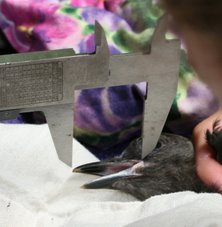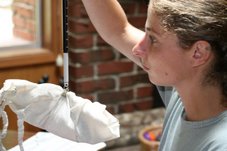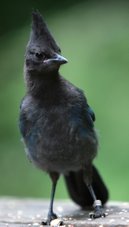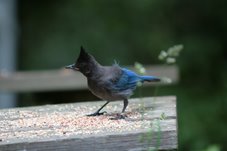NOTES
Wednesday, July 25, 2007
Birds:
1. mwbw (Checkers)
2. mwlblb (Tame Bird)
3. mlbob (Mrs. Go)
4. mrgo (Mr. Go)
5. unbanded (Shopper)
6. mbow (Bow)
7. mgrr (Droopy)
8. unbanded juvenile—going in trap
9. morlb (Red Eye)
10. mwrg (Wringer)
11. banded juvenile
12. mlbrg
13. unbanded with leg mites
Notes:
I’m having trouble keeping track of all the unbanded adult birds here today. Shopper, with his sleeked back crest is easy to identify, as is unbanded with leg mites. His elbows are pink when he bends over, and his legs are swollen where they join his toes. This bird appears small and I suspect may be last year’s juvenile. There is another unbanded bird, quite large, who feeds on the bench with Checkers—lbpmp rattles when he arrives. Rusty Bill may be here, but his red feathers appear to be lighter—a blonder red. The region just below the lower bill is featherless and unusually pink. Could it be another bird, or molting changes?
I’m watching lbpmp carefully. I can almost see a bulge on her right side where her other ear is, but it is completely covered with feathers.
I am getting better at noticing the age differences among the juveniles. Some are getting their blue head stripes. These birds have a long, lean-necked look, while youngsters look plumper, downier, with grayer heads. Many of the juveniles are trying to get peanuts in their gullets, but they just aren’t big enough yet.
I’m curious about Droopy. I would guess she is a male based on her behavior. She is a spunky bird among all these males. They chase her; she chases them. She holds her own and lingers, always in a visible position, always busy. Mrs. Go, the resident female, isn’t as visible, preferring to perch in a tree, higher, in a more camouflaged lookout post. She is shyer, more cautious. It makes me so interested in this idea of “boldness”—its evolutionary advantages and disadvantages.
Subscribe to:
Post Comments (Atom)
Pia Sets the Trap

07/24/07
Peaking...

07/24/07
Oops, wrong bird!

Demonstrating the "hold"
Try Again

Bird in the Bag

Applying a metal band
Measuring

and more measuring. . . .

Blood Sampling

Jeff J's Work

Pia's test tube holder
Weighing

And then....release
When the sun goes down...

Steller's Jay Taxonomy/Description
Common Name: Steller's Jay
Class: Aves
Order: Passeriformes
Family: Corvidae
Genus: Cyanocitta
Species: Cyanocitta stelleri
Steller’s jay belongs to the family, Corvidae, in the Avian Order Passeriformes. Passeriformes is the order of perching birds. Corvidae is the jay, magpie and crow family. The Steller's jay's scientific name is Cyanocitta stelleri. The generic name, cyanocitta, means "blue jay". Its specific name, stelleri, named for George W. Steller (1709-1746). Steller was a German zoologist who explored the coastal areas of the northern Pacific Ocean in 1740.
Band Colors
black | white | purple | red | orangeBands are read in the following order:
light blue and light blue | green
Note: Light blue is difficult to read. It darkens with age, resembling a green band. (b/w/p/r/o/lb/g)
right bottom band
right top band
left bottom band
left top band
Data Collecting
This information was copied from the website of Dr. Jeff Black, Humboldt State University Wildlife Department.
The data to include for each record:
- Bird’s color code
- Size of social group seen at the same time
- Associates’ color codes (or if unbanded = UNB; or not determined = NOTD)
- Number of times associates came within 3 meters of each other
- Approximate time spent within 3 meter distance (e.g. 2 seconds, 15 sec, etc.)
- Total time you watched the birds (e.g. 5 minutes, 10 min, etc.)
- Time of day; start of observation (e.g. 1935)
- Date (e.g. 9.30.99)
- Location of observation (e.g. Rewood Bowl SW corner west bleachers. And state whether the bird was seen at a birdfeeder or in trees, etc)
- Comments (e.g. deformed leg, feather tuft on back, etc.)
Arcata Steller's Jay Sightings
Mr. Go

































No comments:
Post a Comment